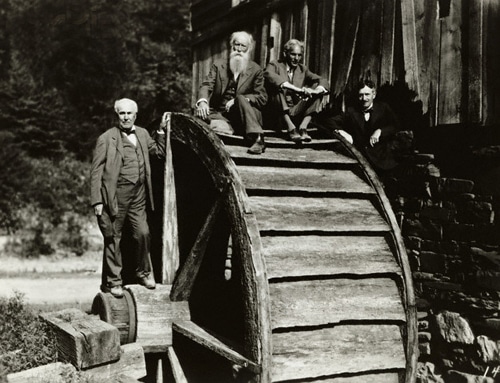
When success guru Napoleon Hill interviewed Andrew Carnegie, inquiring as to the secret of his success, Carnegie replied that it could be traced to the “sum total of the minds†of his business associates–his managers, accountants, chemists and so on. He called this combined brain power a “master mind,†and attributed to it the power of his success.
Hill came to believe that a “Master Mind†was not only the key to Carnegie’s success, but the secret to the success of all great men, the “very foundation stone of all outstanding personal achievements.â€
What Is a Master Mind?
Napoleon Hill’s The Law of Success defines the Master Mind as “a mind that is developed through the harmonious co-operation of two or more people who ally themselves for the purpose of accomplishing any given task.†Hill believed that our minds were made of up fluid or energy (what he called “the electrons of the etherâ€) and that these energies combined to either unfortunate or happy effect when individuals met together. When two or more minds interacted, it produced a third mind, although not necessarily a Master Mind. For a Master Mind to be formed, the individuals in a given group had to possess positive energy and a shared definite aim. Most importantly, the individuals had to be in complete harmony with one another. When these requirement were satisfied, a Master Mind was created. All the individuals in the group had access to this third mind; tapping into it provided inspiration and recharged the brains of all the individuals in the group. Hill elaborated on how this works:
“Each person in the group becomes vested with the power to contact with and gather knowledge through the ‘subconscious’ minds of all the other members of the group. This power becomes immediately noticeable, evidencing itself in the form of a more vivid imagination and the consciousness of what appears to be a sixth sense. It is through this sixth sense that new ideas will “flash†into the mind. If the entire group has met for the purpose of discussing a given subject, ideas concerning that subject will come pouring into the minds of all present. These ideas take on the nature and form of the subject dominating the mind of the individual. The minds of those participating in the ‘Master Mind’ become as magnets, attracting ideas and thought stimuli of the most highly organized and practical nature…â€
Wait, What?
Mr. Hill had a great number of very good things to say about the principles of success. But for me personally, his penchant for pseudo-science and “Secret-esque” lingo can sometimes get in the way of the message.
So allow me to put the Master Mind idea into more straightforward terms: two brains are better than one and iron sharpens iron. When we gather together with others to throw around ideas, discuss and debate, and receive both criticism and inspiration, we grow and develop as men and foster new ideas while refining our old ones. The choice of one’s associates also influences us in subtle ways; hang around those who are ambitious and going places and you find yourself striving to do likewise; spend time with the pessimistic and lazy and you’ll soon sink to their level. Gathering in Master Mind groups for the express purpose of mutual improvement can take us farther than we could ever have gone alone.
Next time we’ll discuss how to form your own Master Mind group. For now, we offer a look at examples of four different kinds from history which highlight the great power and possibilities of a Master Mind.
The Inklings
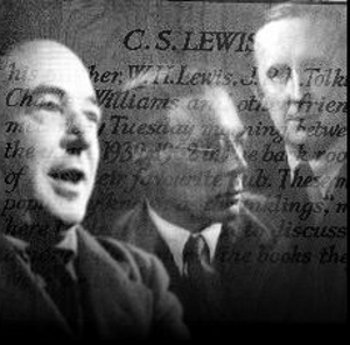
Two classic series of literature, The Chronicles of Narnia and The Lord of the Rings were honed and improved by a Master Mind in Oxford, England. This group was called The Inklings and included an assortment of great poets and writers such as CS Lewis, JRR Tolkien, Charles Williams, and Owen Barfield.
The men would meet in Lewis’ rooms at Magdalen College on Thursday or Friday evenings and at a local pub, the Eagle and Child (or as the Inklings affectionately dubbed it, the “Bird and Babyâ€), on Tuesday mornings before lunch. Over tea, pipe smoke, and beer, these writers and old friends enjoyed what Lewis referred to as the “the cut and parry of prolonged, fierce, masculine argument.â€
The members of the Inklings would read aloud from their most recent writings such as The Screwtape Letters and The Hobbit in the case of Lewis and Tolkien respectively. The other members would then offer very frank criticism and commentary on what they heard. Lewis said the members’ final works owed “a good deal to the hard hitting criticism of the circle. The problems of narrative as such-seldom heard of in modern critical writings-were constantly before our minds.â€
But literature was hardly the only topic discussed by the group, nor was it a rigidly structured affair. Rather, the debates and conversations were casual and free wheeling, veering from the importance of myth, symbolism, and romance in literature to philosophy and culture and of course faith and theology—most, although not all, of the Inklings were Christians. Lewis said, “We meet…theoretically to talk about literature, but in fact nearly always to talk about something better. What I owe to them all is incalculable.â€
The meetings in Lewis’ rooms lasted from 1933 to 1949, concluding as Tolkien finished the Lord of the Rings. The more informal pub meetings continued until Lewis’ death in 1963.
The Tennis Cabinet
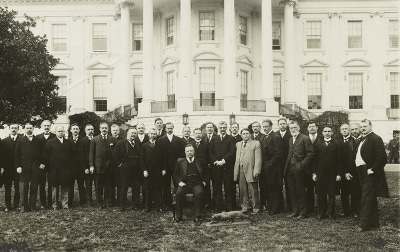
Theodore Roosevelt and the Tennis Cabinet
When Theodore Roosevelt assumed the presidency, he became at age 42 the youngest president in the country’s history and brought an unprecedented zest and vitality to the White House. A man who placed a premium on living the strenuous life, he liked to get a couple hours of physical exercise in the afternoons. Accompanying him for these excursions of “vigorous play†were a group of men TR referred to as his “Tennis Cabinet.†As Roosevelt often butted heads with the old curmudgeonly men who filled government office, he preferred to spend time with younger gents and those who brought a fresh enthusiasm to Washington. The Tennis Cabinet included friends from his days in the West, diplomats, comrades in arms like Major-General Leonard Wood, fellow conservationist Gifford Pinchot, Maine guide and Badlands pal Bill Sewell, and young military aides like the grandsons of Generals Lee and Grant. TR and the Tennis Cabinet hiked, climbed cliffs, rode horses, skinny dipped in the Potomac River (even in early spring when there was still ice floating in the water!), and, of course, played tennis. The men exercised their minds as they worked their bodies, discussing and debating the pressing issues of the day and planning out the best way to proceed. As a friend of Roosevelt remembered, “For that once in our history, we had an American salon.â€
This group of men was just as beloved to TR as his Rough Riders, and he told Pinchot they were much closer to him than his official cabinet. Roosevelt bid farewell to his time as President by holding a luncheon for members of his Tennis Cabinet. He addressed these indispensable advisers by saying:
“I do not believe this country has ever had an abler or more devoted set of public servants. It is through you and those like you that I have done the major part of what has been accomplished under this administration…The credit has come to me, to the chief of the administration. For exactly as men like to symbolize a battle by the name of the commander, so they like to symbolize an administration by the man at the head, forgetting that the immense majority of his acts can be done only through others and that a really successful administration, successful from the standpoint of advancing the honor and the interests of the country, must be managed as ours has been, in a spirit of the most loyal association and partnership.â€
Many members of the audience, overcome with gratitude to have served by TR’s side, openly wept at the dissolution of this one of a kind Master Mind.
The Junto
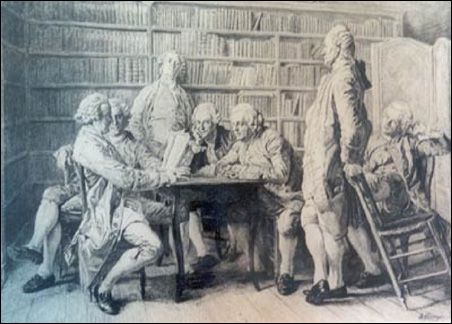
In 1727, Benjamin Franklin formed the Junto, a mutual improvement society born of Franklin’s love of conversation, personal progress, philosophy, and civic involvement. The group originally had 12 members and was composed of workingmen–the tradesmen and artisans who did not have a place in more elite circles of society. The Junto was thus commonly referred to as the “Leather Apron Club.â€
Franklin describes this Master Mind group in his autobiography:
“I should have mentioned before, that, in the autumn of the preceding year, I had formed most of my ingenious acquaintance into a club of mutual improvement, which we called the Junto. We met on Friday evenings. The rules that I drew up required that every member, in his turn, should produce one or more queries on any point of Morals, Politics, or Natural Philosophy, to be discussed by the company; and once in three months produce and read an essay of his own writing, on any subject he pleased. Our debates were to be under the direction of a president, and to be conducted in the sincere spirit of inquiry after truth, without fondness for dispute, or desire of victory…â€
The group’s discussions ranged from the abstract and philosophical to the scientific and pragmatic, from questions on “What is wisdom?†to “Why does condensation form on a cold mug?†The members also imparted news on the latest goings on in business, social life, and politics.
For Franklin, keeping the Junto from devolving into rancorous debate was of the utmost importance. To this end he employed a gentle Socratic method during discussions, drawing the opinions out of members with questions couched in curiosity instead of attack. The rules dictated that those who insisted on being contentious would be charged small fines.
Many of the ideas and public improvements often attributed to Franklin alone, such as the volunteer fire department, subscription library, and public hospital, were really spurred by this colonial Master Mind.
The Junto lasted for more than 30 years and was so popular that Franklin allowed members to form their own spin-off groups. Franklin himself used the Junto as the foundation for a much larger group-the American Philosophical Society.
The Vagabonds
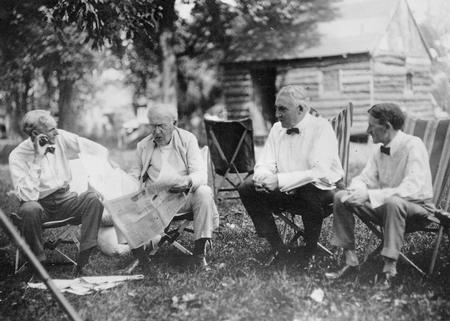
The Vagabonds: From left to right: Henry Ford, Thomas Edison, Warren G. Harding, Harvey Firestone
Out in the country and driving through the rain in an old Model T, a farmer noticed five men standing by a Lincoln touring car which was stuck in the mud. He stopped and assisted in pulling the car out of the muck, at which point one of the men stepped forward to shake his hand, telling the farmer, “I made the car you’re driving.” “And I’m the man who made those tires,” added another in the group. He then pointed to two of the others, saying, “Meet the man who invented the electric light — and the President of the United States.” When the fifth man asked the farmer, “I guess you don’t know me either?” the farmer replied, “No, but if you’re the same kind of liar as these other darn fools, I wouldn’t be surprised if you said you was Santa Claus.”
The farmer’s chagrin was quite understandable. He had inadvertently stumbled upon a seemingly unlikely Master Mind group: Henry Ford, the automobile mogul, Harvey Firestone, founder of the Firestone Tire and Rubber Company, Warren G. Harding, US President, Thomas Edison, famed scientist and inventor, and Luther Burbank, respected agriculturist were on their way together to a campsite.
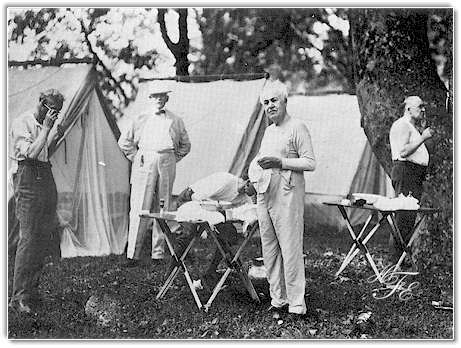
Camping in 1921 in the Great Smokies. Left to right: Ford, Bishop William F. Anderson, Firestone (stooping), Edison and Harding.
Starting in 1915, Edison, Firestone, and Ford, along with the naturalist Thomas Burroughs before his death in 1921, and a rotating cadre of guest members like Burbank and President Calvin Coolidge, took to the road each summer in motor camping caravans, road tripping from state to state on their way to rustic campsites. These eminent men and best friends called themselves “The Vagabonds†and eagerly looked forward to their “gypsy†trips together each year.
The men spent their camping trips competing in impromptu tree chopping and climbing contests, allowing what Edison called “Nature’s Laboratory†to inspire them to new ideas, and sitting around the campfire discussing their various scientific and business ventures and debating the pressing issues of the day. The yearly trips lasted until 1924 when several factors led to their demise: Harding died, newspaper reporters and photographers swarmed the campsites, and the men’s wives started coming along, bringing with them their maids and chauffeurs.
Nonetheless, the men continued to meet together, often gathering in the man room at Henry Ford’s Fair Lane estate, a den where carved oak busts of Edison, Burroughs, and Firestone hung on the wood paneled walls.
These four examples only scratch the surface of the great Master Mind groups that have existed throughout history. What are some other noteworthy mutual improvement societies?
Tags: Friendship

